The difference between single vision lenses and functional lenses
The difference between single vision lenses and functional lenses: different effects, different matching methods, different types, different functions, and different manufacturing purposes.
The effect is different
Single vision lenses correct central vision but not peripheral vision. Functional lenses can effectively place images around the retina in front of the retina, avoid hyperopia and defocus, and can be achieved with the eye at long, intermediate, and short distances.
Different glasses
Single-vision lenses only detect the degree, and then you can use the optometry film to match the glasses. Functional lenses also need to provide monocular pupil distance, monocular pupil height, distance, downward acceleration, channel length, lens viewing distance, anteversion angle, etc. The more comprehensive the data, the higher the wearing comfort.
different types
Single-vision lens means that the lens has only one optical center, and can only perform visual correction from the effective area of the optical center. The film has no complex processes such as anti-ultraviolet, anti-blue light, and anti-fog. Functional lenses are a mix of functions, including tinted lenses, progressive addition lenses, prism lenses, and more.

different functions
Functional lenses have a stronger anti-blue light function than ordinary lenses. While correcting vision, functional glasses can also reduce the damage to the eyes caused by radioactive objects such as mobile phones and computers. Functional lenses are an upgraded version of ordinary lenses. The materials used are more wear-resistant and scratch-resistant than ordinary glasses, which prolongs the service life. Functional lenses will change color under ultraviolet radiation to protect the eyes from ultraviolet rays.
Manufacturing purpose is different
Single vision lenses are the eyeballs to adapt to the glasses. Functional glasses can automatically adjust the function according to the change of the environment, instantly change the visual experience to protect the health of the human eye, and achieve the effect of "the glasses can automatically adjust the function to actively adapt to the eyes and improve vision at the same time".
How to choose the glasses that suit you:
Single-vision VS function: Compared with single-vision lenses, functional lenses can meet more eye needs. If the eye axis is normal and the visual function is normal, you can choose single-vision lenses; but if you have presbyopia, abnormal adjustment function, Myopia and esophagus at the same time, may consider choosing progressive multifocal lenses.
Lens Refractive Index: The high or low refractive index reflects the thickness of the lens; some friends with high numbers are worried that the glasses are too thick, so they can choose lenses with high refractive index to reduce the thickness of the lens.
Glass VS Resin: Resin lenses have the characteristics of light weight, not easy to break, and light transmittance comparable to glass lenses. At present, resin lenses are generally used; patients with special requirements or high degrees can choose glass lenses.
Spherical VS Aspheric: The visual quality of spherical or aspheric lenses is different; the periphery of spherical lenses has a certain curvature, so that the edge of the object image may appear curved; the imaging quality of aspheric lenses is better.
